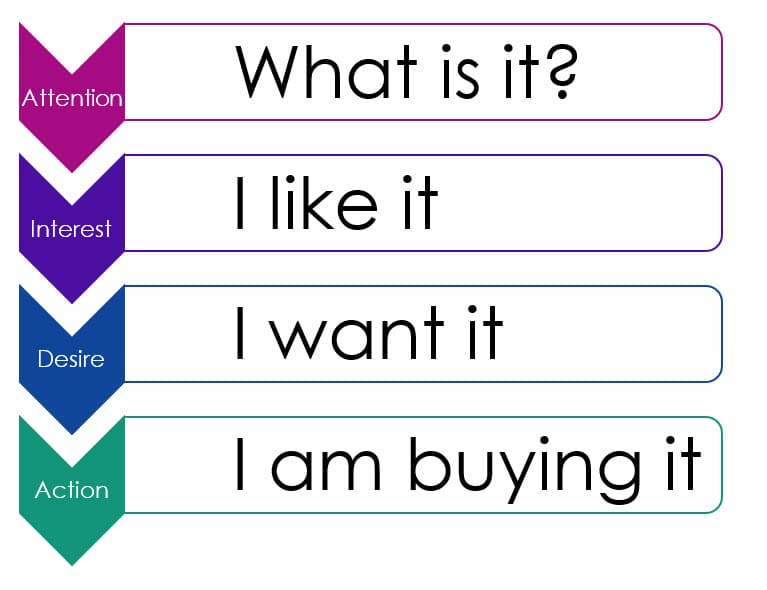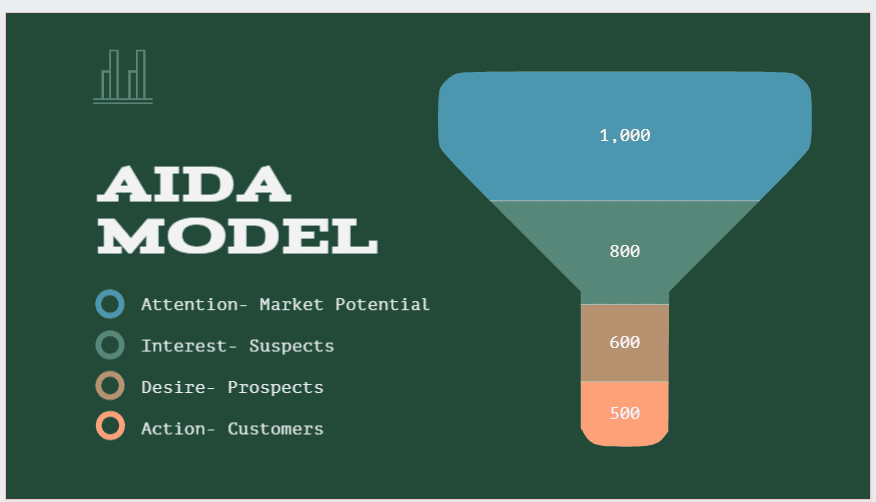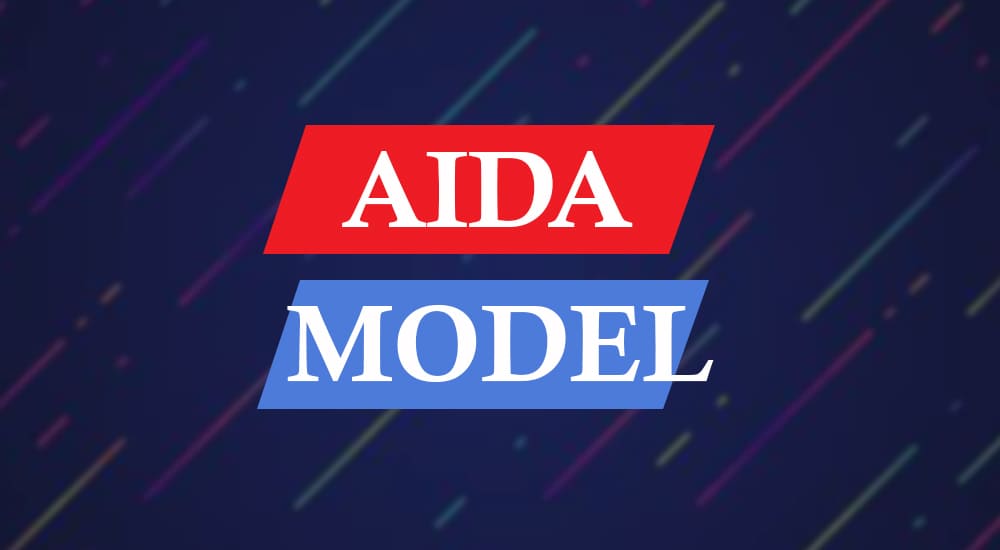Consumers may not realize how businesses strategically analyze their buying behavior and influence them at every stage, right from knowing the brand until they buy the product or service.
Businesses use the AIDA model to achieve the above objectives.
Definition: The AIDA model stands for Attention/Awareness, Interest, Desire, and Action. This model breaks down the customer buying journey into different parts. Then, the business can plan strategies to influence each part, so visitors are constantly engaged with the brand and finally become a buyer.
The AIDA model is used in digital marketing, sales, public relations, and campaigns to collect leads and then convert leads into customers.

Steps in the AIDA Model
The steps involved in the AIDA model are:
- Attention: The first step in the AIDA model is to grab customers’ attention and make them aware of the brand and the product.
- Interest: After making the audience aware of the product, the business must increase the audience’s interest level, so they start liking the product.
- Desire: After the audience is interested in the product, the goal is to make them feel like they want the product.
- Action: The goal of this model is to grab the leads’ attention and push them to take buying action.
A visitor moves through each stage of the AIDA model, interacting with the product or service until they purchase the product and become a customer. There is also a possibility that customers can directly jump from the attention phase to the action phase.

Let’s say an advertisement attracts 1,000 visitors who see the ad and learn about the product. Out of these visitors, 800 show interest in it. From this, at least 600 want to buy it, and eventually, 500 of them make a purchase and become customers.
Who Created the AIDA Model?
The AIDA model was introduced in 1898 by American advertising and sales pioneer St. Elmo Lewis in one of his publications on advertising.
In his words:
“The mission of an advertisement is to attract a reader so that he will look at the advertisement and start to read it; then to interest him, so that he will continue to read it; then to convince him so that when he has read it, he will believe it. If an advertisement contains these three qualities of success, it is a successful advertisement.”
Elmo Lewis
Put simply; an advertisement is good if it meets three qualities: attract attention, generate the interest of an audience, and then convince them to buy the goods or services.
What is the AIDA Approach?
- Attract Attention: The ad should be eye-catching to generate interest in the audience, so they want to know more about the product; e.g., a sensational YouTube clip trending in the top 10 will create curiosity for visitors to browse it further.
- Maintain Interest: Once the audience wants to know more, they should be provided with more information. e.g., more descriptions, flyers, photos, video, etc.
- Create Desire: Once interest in the product is created, the audience should feel that they wish to own it. For example, the advertisement can provide the advantages of the product, how it can solve their problems, etc.
- Take Action: Once a customer feels they want the product, the call to action should be easily reachable to buy the product. There should be an add to cart/buy now button for online shopping.
How to Use the AIDA Model
Stage 1: Attention/Awareness
The first impression is the last. A brand must grab the customers’ attention right away. Brands often assume that their audience knows all about them, but this is not true. To gain the interest of the audience, a brand should have an attention-grabbing advertisement.
For an email, the subject should be catchy.
Consider another example of an eCommerce website: the site should have banners to catch the attention of the visitors. It is preferable to personalize content for each consumer category.
To catch the attention of the audience, businesses should analyze the audience and their persona. Consider their background, industry, obstacles, motivations, and even seasonality to understand why they may be interested in listening.
Stage 2: Interest
After the business crosses stage 1 and has gained the attention of the customers, the challenge is to keep them engaged. For example, in the case of email, why should they read the email?
Personalization helps connect with readers to show them that businesses understand and care for them. The more aligned the business is with the audience’s needs, the more likely it is that the business will succeed.
Provide enough information to keep the audience engaged but don’t bombard them with too much information. In the case of the eCommerce website, breaking the content into readable paragraphs with interesting subheadings and illustrations is a good strategy. The goal is to ensure that customers do not feel they are the product.
Stage 3: Desire
Once the customer is engaged, tell them the business’s offering and its benefits so that their interest can turn into desire, making them want the product or service. Sometimes customers might not need a product, but businesses create an ad in a way that encourages the audience to want it. Businesses do this by comparing the product with similar products or services.
Case studies or testimonials can be shown to help generate a desire to buy. There should be uniqueness in the product or service and customer-focused benefits.
If the organization is running a blog, visitors should be able to subscribe to it, which shows the audience wants more content. Likewise, for mobile apps, the audience should be able to download easily.
Stage 4: Action
Now, the audience has a strong desire to buy the product, so there must be a call to action. Be direct about the next steps the business wants a potential lead to take. Don’t confuse them with lots of options and unclear choices. There should be clear visibility on whether they should proceed to buy, download the app or subscribe with their email or fill out the short contact form.
Businesses can push visitors to act with early bird discounts, free trials, one-on-one offers, referral systems, and other options like “Pay Later” and “EMI” can also be considered.
Examples of AIDA Model
- A popular example of creating “Attractiveness” is Happydent White (India), where they came up with the creative idea of lightening the dark places with their chewing gum.
- A popular example of creating “Interest” is Cred (a credit card app in India) which is creating interest with all its vintage ads.
- Popular examples of creating “Desire” are Wendy’s “Where’s the beef” ad and L’Oreal with customized messages to subscribed customers and their cross-selling opportunities.
- Popular examples of “Action” steps are the Amazon limited deal and the Amazon lightning deal.
Limitations of the AIDA Model
- The AIDA model is straightforward, and some products might create interest and desire, but the audience will eventually buy other products.
- The AIDA model doesn’t say anything about impulse buyers or short sales cycles because some leads would like to pass through all AIDA stages in one shot.
- The AIDA model is limited to first-time customer purchases and doesn’t discuss retaining existing customers or cross-selling and upselling options.
- Companies might focus on one or more parts of the AIDA model (e.g., attractiveness), and their businesses might suffer.
There are other models to overcome these limitations, such as:
- AIDCAS (Action, Interest, Desire, Confidence, Action, Satisfaction) model
- REAN (Reach, Engage, Activate, and Nurture) model
- NAITDASE (Need, Attention, and Interest; Trust, Design, and Action; Satisfaction and Evaluation) model
- Hierarchy of Effects (Awareness, Knowledge, Liking, Preference, Conviction, Purchase)
- Modified AIDA (Awareness, Interest, Conviction, Desire, Action [purchase or consumption]) model
- AIDAS (Attention, Interest, Desire, Action, Satisfaction) model
- AISDALSLove (Attention, Interest, Search, Desire, Action, Like/Dislike, Share, and Love/Hate) model
Conclusion
AIDA is a marketing model introduced in the 19th century but is discussed even today because of its usefulness and popularity. Many other models were developed based on this model. Any business that wants to focus on its customers should think of strategically applying the AIDA model.

Well Explained